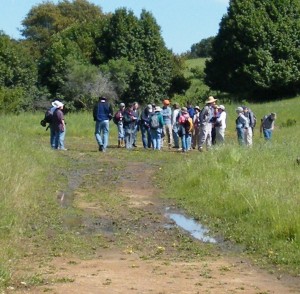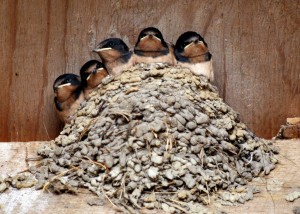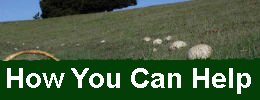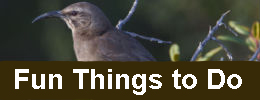It comes as no surprise that the Oakland Zoo has announced that it will seek yet another source of public funding (up to $5 million a year), this time from Alameda County residents. The zoo has been soliciting support for the county-wide tax measure on its website page, “It’s Your Zoo.” The zoo already receives money from Alameda and Contra Costa residents through the East Bay Regional Park District (EBRPD) which taps residents for a portion of their parcel taxes through its special tax district (check your property tax bill and you’ll see it listed).
Oakland’s “Disappeared” Park: Why Oaklanders Don’t Know Knowland –And Why They Should Get There Before it’s Gone
Some people, touring Knowland Park for the first time, express astonishment at the idea that the City of Oakland has purposely NOT listed this wonderful park on its Parks and Recreation website list of city parks. We felt the same way when we discovered that the largest remaining open space owned by the city wasn’t listed anywhere, and that there was no signage to help people find the Park and enjoy it. Thinking it surely must be an oversight, we asked our city councilman about it, and he said he would look into it. However, despite repeated queries, we never got an answer. This was about four years ago.
Bait and Switch: How the Zoo and the City of Oakland used a 1998 MOU to Mislead the Community
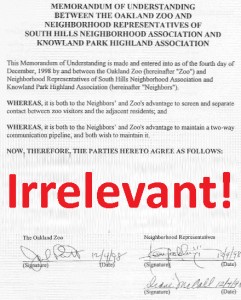 The current legal case is a complicated one. Part of the difficulty arises because a very different version of the Zoo’s expansion plan was approved in 1998 than the one approved in 2011. When the Zoo presented its expansion plan in 1997, there had been considerable community outcry, because those plans were quite different from what had been originally described in the 1996 Zoo Master Plan. So, city-facilitated meetings between community representatives and the Zoo were held over a period of many months. These meetings, described as grueling by the volunteer community representatives, finally resulted in a Memorandum of Understanding (MOU) signed by Dr. Joel Parrott, the executive director of the Zoo, and representatives of community groups, one of which was the direct predecessor of Friends of Knowland Park.
The current legal case is a complicated one. Part of the difficulty arises because a very different version of the Zoo’s expansion plan was approved in 1998 than the one approved in 2011. When the Zoo presented its expansion plan in 1997, there had been considerable community outcry, because those plans were quite different from what had been originally described in the 1996 Zoo Master Plan. So, city-facilitated meetings between community representatives and the Zoo were held over a period of many months. These meetings, described as grueling by the volunteer community representatives, finally resulted in a Memorandum of Understanding (MOU) signed by Dr. Joel Parrott, the executive director of the Zoo, and representatives of community groups, one of which was the direct predecessor of Friends of Knowland Park.
21st Century Conservation
What does conservation mean in the 21st century, and why is it so needed? The world faces an unprecedented loss of species as we enter the second decade of this century. As the renowned naturalist E.O. Wilson wrote, way back in 1980:
“The worst thing that can happen, will happen… Not energy depletion, economic collapse, limited nuclear war, or conquest by a totalitarian government. As terrible as these catastrophes would be for us, they can be repaired within a few generations. The one process going on in the 1980s that will take millions of years to correct is the loss of genetic and species diversity by the destruction of natural habitats. This is the folly our descendants are least likely to forgive us.”
“Wisdom Sits in Places”: Knowland Park’s abiding meaning
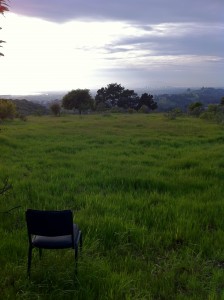 More than a decade ago, I read a book by the University of New Mexico anthropologist Keith Basso that made an enormous impression on me and forever changed the way I experience nature. Called Wisdom Sits in Places, it was a report of the authors’ several years spent studying the Apache culture of the southwestern U.S. One of its most profound contributions was to interpret the Apache relationship with place.
More than a decade ago, I read a book by the University of New Mexico anthropologist Keith Basso that made an enormous impression on me and forever changed the way I experience nature. Called Wisdom Sits in Places, it was a report of the authors’ several years spent studying the Apache culture of the southwestern U.S. One of its most profound contributions was to interpret the Apache relationship with place.
In many ways, it is impossible for those of us not raised within a culture to ever entirely understand it, so it is with caution that I approach trying to convey what was so immensely powerful about this little book. It’s also been many years now since it so impressed me, so it is possible that memory has embroidered my understanding. But the primary message I took from Basso’s reported conversations with tribal members and elders was that place matters –and it matters as more than mere location: Natural places reveal something to us about our relationships with the world and one another.
Save Oakland’s Oaks
Expansion Controversy
Search Our SIte
Blog Categories
Regular Bloggers
 Ruth Malone |
 Laura Baker |
 Jim Hanson |
 Mack Casterman |
We support Oakland's public spaces!

 Follow
Follow